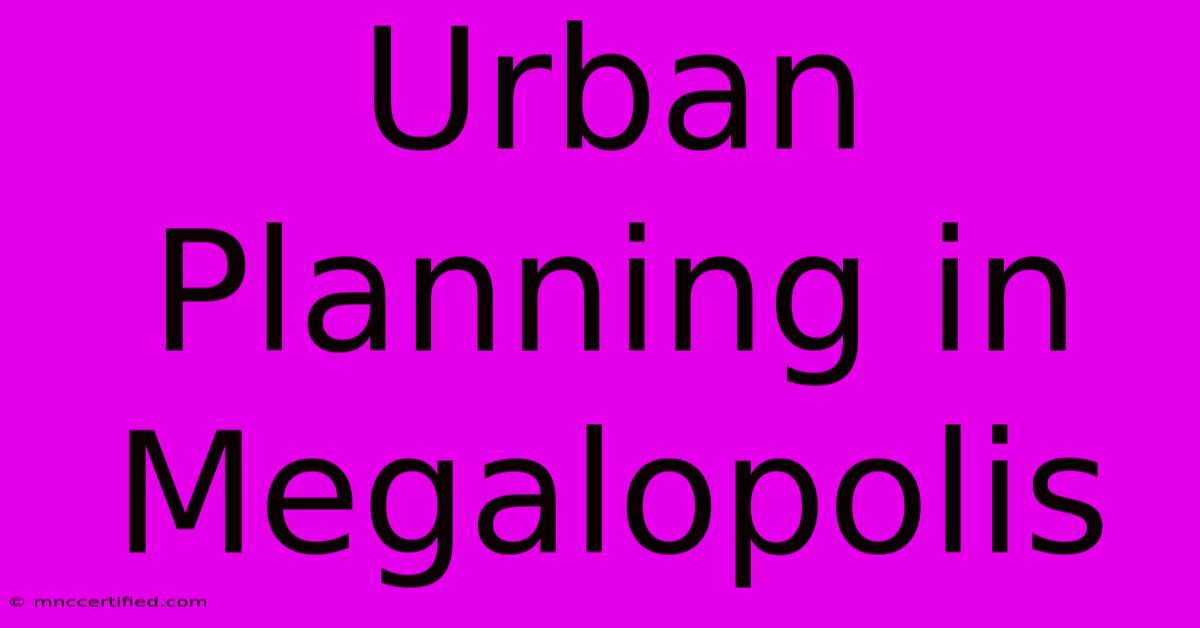Urban Planning In Megalopolis

Table of Contents
Urban Planning in Megalopolis: Navigating the Challenges of Supersized Cities
The world is increasingly urbanizing, with a growing proportion of the population residing in cities. This trend has led to the emergence of megalopolises, vast urban agglomerations that encompass multiple cities and towns, often interconnected by transportation networks and economic activity. These supersized urban centers present unique challenges for urban planning, demanding innovative solutions to ensure sustainable, equitable, and efficient growth.
The Challenges of Urban Planning in Megalopolises
Megalopolises face a complex web of challenges, including:
- Population Growth and Density: Rapid population growth leads to immense pressure on infrastructure, housing, and services. The high density of these urban areas can also exacerbate problems like traffic congestion and pollution.
- Transportation Networks: Managing efficient and sustainable transportation systems in megalopolises is crucial. The complex web of roads, railways, and public transit needs careful planning and coordination to ensure smooth movement of people and goods.
- Resource Management: Megalopolises consume vast amounts of resources like water, energy, and food. Sustainable management of these resources is critical for ensuring long-term viability.
- Environmental Sustainability: Megalopolises contribute significantly to environmental challenges like air pollution, water contamination, and climate change. Sustainable urban planning is essential to mitigate these negative impacts.
- Social Equity: Ensuring equitable access to resources, services, and opportunities for all residents is crucial in megalopolises. This includes addressing issues like affordable housing, healthcare, and education.
Strategies for Effective Urban Planning
To navigate these challenges, urban planners in megalopolises are implementing a variety of strategies:
- Integrated Planning: A comprehensive approach that considers the interconnectedness of different aspects of urban development, including transportation, housing, infrastructure, and environmental sustainability.
- Smart City Technologies: Leveraging data analytics, sensor networks, and intelligent systems to optimize city operations, enhance infrastructure efficiency, and improve public services.
- Sustainable Transportation Systems: Promoting public transit, cycling, and walking, while reducing reliance on private vehicles, can alleviate traffic congestion and improve air quality.
- Green Building Design: Encouraging sustainable construction practices, incorporating green spaces, and optimizing energy efficiency can help reduce the environmental footprint of megalopolises.
- Mixed-Use Development: Creating urban areas with a mix of residential, commercial, and recreational spaces can promote walkability, reduce dependence on cars, and foster a vibrant urban environment.
- Public Participation: Engaging citizens in the planning process is crucial to ensure that urban development plans reflect the needs and aspirations of the community.
Examples of Successful Initiatives
Several megalopolises have implemented innovative urban planning strategies:
- Singapore: The city-state has adopted a comprehensive approach to urban planning, focusing on sustainable development, efficient transportation, and high-quality living standards.
- Tokyo: The Japanese capital has implemented smart city technologies to optimize traffic flow, improve public safety, and enhance resource management.
- New York City: The city has invested in green infrastructure projects, bike lanes, and public transit systems to improve sustainability and mobility.
Looking Ahead: The Future of Megalopolis Planning
The future of urban planning in megalopolises hinges on:
- Innovation and Technology: Continuously adopting new technologies and finding creative solutions to address the growing challenges.
- Sustainability and Resilience: Building urban environments that are resilient to climate change, resource scarcity, and other potential threats.
- Social Equity and Inclusiveness: Ensuring that all residents have access to opportunities and a high quality of life.
Megalopolises are complex and dynamic urban environments. By embracing innovative planning strategies and fostering collaboration among stakeholders, these supersized cities can continue to thrive while creating a more sustainable and equitable future for their residents.

Thank you for visiting our website wich cover about Urban Planning In Megalopolis. We hope the information provided has been useful to you. Feel free to contact us if you have any questions or need further assistance. See you next time and dont miss to bookmark.
Featured Posts
-
John Krasinskis Wife Emily Blunt Reacts
Nov 14, 2024
-
Insurance Companies In La Crosse Wi
Nov 14, 2024
-
Thune Elected New Senate Republican Leader
Nov 14, 2024
-
Malaga Flooding Red Alerts Hit Costa Del Sol
Nov 14, 2024
-
New Bridget Jones Trailer Released
Nov 14, 2024